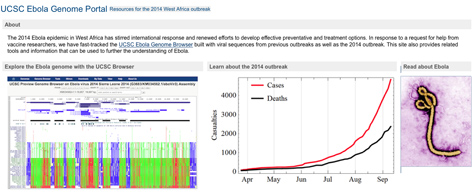The UC Santa Cruz Genomics Institute late Tuesday (September 30) released a new Ebola genome browser to assist global efforts to develop a vaccine and antiserum to help stop the spread of the Ebola virus.
The team led by University of California, Santa Cruz researcher Jim Kent worked around the clock for the past week, communicating with international partners to gather and present the most current data. The Ebola virus browser aligns five strains of Ebola with two strains of the related Marburg virus. Within these strains, Kent and other members of the UC Santa Cruz Genome Browser team have aligned 148 individual viral genomes, including 102 from the current West Africa outbreak.
UC Santa Cruz has established the UCSC Ebola Genome Portal, with links to the new Ebola genome browser as well as links to all the relevant scientific literature on the virus.
“Ebola has been one of my biggest fears ever since I learned about it in my first microbiology class in 1997," said Kent, who 14 years ago created the first working draft of the human genome. "We need a heroic worldwide effort to contain Ebola. Making an informatics resource like the genome browser for Ebola researchers is the least we could do.”
Scientists around the world can access the open-source browser to compare genetic changes in the virus genome and areas where it remains the same. The browser allows scientists and researchers from drug companies, other universities, and governments to study the virus and its genomic changes as they seek a solution to halt the epidemic.
The release of the new Ebola genome browser comes as the U.S. Centers for Disease Control and Prevention Tuesday confirmed the first case of Ebola in the United States.
The Ebola browser was started shortly after a phone conversation between Kent and his sister, an epidemiologist at the CDC, who spoke of how she and her staff were consumed with Ebola research in the face of the escalating crisis. UC Santa Cruz Professor Phil Berman, an HIV specialist, had also asked Kent for help with his efforts in developing a vaccine for Ebola.
Kent asked his supervisor, UC Santa Cruz bioinformatics researcher David Haussler, if he could divert his team to Ebola work. Haussler replied with an enthusiastic affirmative, and they pulled together a team of UC Santa Cruz bioinformatics scientists that, within a week, was able to create a fully functional Ebola genome browser.
"The incredible speed with which this group was able to assemble all the genetic information about Ebola and make it available to the world shows what a great team Jim Kent has assembled," Haussler said.
In June 2000, Kent and Haussler released the first working draft of the human genome sequence on the web. Two months later, Kent developed the UCSC Genome Browser, which has become an essential resource to biomedical science.
In a similar marshaling of forces in the face of a worldwide threat 11 years ago, UC Santa Cruz researchers created a SARS virus browser.
The UC Santa Cruz Genomics Institute provides the organizing framework, focus, and leadership for the next great leap in the science of genomics and human health.



